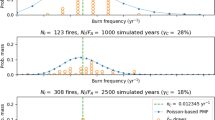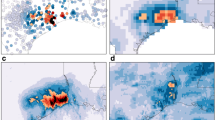Abstract
We present our submission to the Extreme Value Analysis 2021 Data Challenge in which teams were asked to accurately predict distributions of wildfire frequency and size within spatio-temporal regions of missing data. For this competition, we developed a variant of the powerful variational autoencoder models, which we call Conditional Missing data Importance-Weighted Autoencoder (CMIWAE). Our deep latent variable generative model requires little to no feature engineering and does not necessarily rely on the specifics of scoring in the Data Challenge. It is fully trained on incomplete data, with the single objective to maximize log-likelihood of the observed wildfire information. We mitigate the effects of the relatively low number of training samples by stochastic sampling from a variational latent variable distribution, as well as by ensembling a set of CMIWAE models trained and validated on different splits of the provided data.



Similar content being viewed by others
Data availability
The data are available from the organizers of the Extreme Value Analysis 2021 Data Challenge, https://www.maths.ed.ac.uk/school-of-mathematics/eva-2021/competitions/data-challenge. Data are also available from the authors upon reasonable request and with permission of the organisers of the Data Challenge.
Code availability
Our model, training and evaluation code is available at https://github.com/Blackbox-EVA2021/CMIWAE.
References
Bratti, J., Gaya, J., Drews-Jr, P., Botelho, S., Protas, É.: Understading image restoration convolutional neural networks with network inversion. In: 2017 16th IEEE International Conference on Machine Learning and Applications (ICMLA), pp. 215–220 (2017). https://doi.org/10.1109/ICMLA.2017.0-156
Burda, Y., Grosse, R., Salakhutdinov, R.: Importance Weighted Autoencoders. Paper presented at the 4th International Conference on Learning Representations (ICLR), San Juan, Puerto Rico, 2–4 May 2016 (2016). https://doi.org/10.48550/arXiv.1509.00519
Domke, J., Sheldon, D.: Importance weighting and variational inference. In: Bengio, S., Wallach, H., Larochelle, H., Grauman, K., Cesa-Bianchi, N., Garnett, R. (eds.) Proceedings of the 32nd International Conference on Neural Information Processing Systems. NIPS’18, pp. 4475–4484. Curran Associates Inc., Red Hook, NY, USA (2018). https://papers.nips.cc/paper/2018/hash/25db67c5657914454081c6a18e93d6dd-Abstract.html
Gershman, S.J., Goodman, N.D.: Amortized inference in probabilistic reasoning. In: Proceedings of the Annual Meeting of the Cognitive Science Society, vol. 36 (2014). https://escholarship.org/uc/item/34j1h7k5
Howard, J., et al.: fastai, GitHub (2018). https://github.com/fastai/fastai
Huot, F., Hu, R.L., Goyal, N., Sankar, T., Ihme, M., Chen, Y.-F.: Next day wildfire spread: A machine learning dataset to predict wildfire spreading from remote-sensing data. IEEE Trans. Geosci. Remote Sens. 60, 1–13 (2022). https://doi.org/10.1109/tgrs.2022.3192974
Ioffe, S., Szegedy, C.: Batch Normalization: Accelerating Deep Network Training by Reducing Internal Covariate Shift. (2015). Preprint at https://arxiv.org/abs/1502.03167
Ipsen, N.B., Mattei, P.-A., Frellsen, J.: not-MIWAE: Deep generative modelling with missing not at random data. In: ICLR 2021 - International Conference on Learning Representations, Virtual, Austria (2021). https://hal.inria.fr/hal-03044124
Jia, M., Zhang, C., Zhao, Z., Wang, L.: Bipartite graph attention autoencoders for unsupervised change detection using vhr remote sensing images. IEEE Trans. Geosci. Remote Sens. 60, 1–15 (2022). https://doi.org/10.1109/TGRS.2022.3190504
Karras, T., Laine, S., Aila, T.: A Style-Based Generator Architecture for Generative Adversarial Networks. (2019). Preprint at https://arxiv.org/abs/1812.04948
Kim, D., Hwang, J., Kim, Y.: On casting importance weighted autoencoder to an em algorithm to learn deep generative models. In: Chiappa, S., Calandra, R. (eds.) Proceedings of the Twenty Third International Conference on Artificial Intelligence and Statistics. Proceedings of Machine Learning Research, vol. 108, pp. 2153–2163. PMLR, Cambridge, MA (2020). https://proceedings.mlr.press/v108/kim20b.html
Kindermans, P.-J., Hooker, S., Adebayo, J., Alber, M., Schütt, K.T., Dähne, S., Erhan, D., Kim, B.: In: Samek, W., Montavon, G., Vedaldi, A., Hansen, L.K., Müller, K.-R. (eds.) The (Un)reliability of Saliency Methods, pp. 267–280. Springer, Cham (2019). https://doi.org/10.1007/978-3-030-28954-6_14
Kingma, D.P., Ba, J.: Adam: A Method for Stochastic Optimization. (2017). Preprint at https://arxiv.org/abs/1412.6980
Kingma, D.P., Welling, M.: Auto-Encoding Variational Bayes. In: 2nd International Conference on Learning Representations, ICLR 2014, Banff, AB, Canada, April 14-16, 2014, Conference Track Proceedings (2014). https://doi.org/10.48550/arXiv.1312.6114
Kramer, M.: Nonlinear principal component analysis using autoassociative neural networks. AIChE J. 37, 233–243 (1991)
Krizhevsky, A., Sutskever, I., Hinton, G.E.: ImageNet classification with deep convolutional neural networks. In: Pereira, F., Burges, C.J., Bottou, L., Weinberger, K.Q. (eds.) Advances in Neural Information Processing Systems, vol. 25, pp. 1097–1105. Curran Associates, Inc., Red Hook, NY, USA (2012). https://papers.nips.cc/paper/2012/hash/c399862d3b9d6b76c8436e924a68c45b-Abstract.html
Lai, C., Zeng, S., Guo, W., Liu, X., Li, Y., Liao, B.: Forest fire prediction with imbalanced data using a deep neural network method. Forests 13(7) (2022). https://doi.org/10.3390/f13071129
Mattei, P.-A., Frellsen, J.: MIWAE: Deep generative modelling and imputation of incomplete data sets. In: Chaudhuri, K., Salakhutdinov, R. (eds.) Proceedings of the 36th International Conference on Machine Learning. Proceedings of Machine Learning Research, vol. 97, pp. 4413–4423. PMLR, Cambridge, MA (2019). https://proceedings.mlr.press/v97/mattei19a.html
Nitish, S., Hinton, G., Krizhevsky, A., Sutskever, I., Salakhutdinov, R.: Dropout: A simple way to prevent neural networks from overfitting. J. Mach. Learn. Res. 15(56), 1929–1958 (2014)
Opitz, T.: Editorial: EVA 2021 Data Competition on spatio-temporal prediction of wildfire activity in the United States. Extremes (2022)
Paszke, A., Gross, S., Massa, F., Lerer, A., Bradbury, J., Chanan, G., Killeen, T., Lin, Z., Gimelshein, N., Antiga, L., Desmaison, A., Köpf, A., Yang, E., DeVito, Z., Raison, M., Tejani, A., Chilamkurthy, S., Steiner, B., Fang, L., Bai, J., Chintala, S.: PyTorch: An imperative style, high-performance deep learning library. In: Wallach, H.M., Larochelle, H., Beygelzimer, A., d’Alché-Buc, F., Fox, E.B., Garnett, R. (eds.) Advances in Neural Information Processing Systems 32: Annual Conference on Neural Information Processing Systems 2019, NeurIPS 2019, 8-14 December 2019, Vancouver, BC, Canada, pp. 8024–8035 (2019). http://papers.nips.cc/paper/9015-pytorch-an-imperative-style-high-performance-deep-learning-library
Preisler, H.K., Brillinger, D.R., Burgan, R.E., Benoit, J.W.: Probability based models for estimation of wildfire risk. Int. J. Wildland Fire 13(2), 133–142 (2004). https://doi.org/10.1071/WF02061
Pereira, J.M.C., Turkman, K.F.: Statistical models of vegetation fires: Spatial and temporal patterns. In: Gelfland, A.E., Fuentes, M., Hoeting, H.A., Smith, R.L. (eds.) Handbook of Environmental and Ecological Statistics, p. 20. Chapman and Hall/CRC, Boca Raton (2019)
Rainforth, T., Kosiorek, A., Le, T.A., Maddison, C., Igl, M., Wood, F., Teh, Y.W.: Tighter variational bounds are not necessarily better. In: Dy, J., Krause, A. (eds.) Proceedings of the 35th International Conference on Machine Learning. Proceedings of Machine Learning Research, vol. 80, pp. 4277–4285. PMLR, Cambridge, MA (2018). https://proceedings.mlr.press/v80/rainforth18b.html
Rezende, D.J., Mohamed, S., Wierstra, D.: Stochastic backpropagation and approximate inference in deep generative models. In: Xing, E.P., Jebara, T. (eds.) Proceedings of the 31st International Conference on Machine Learning. Proceedings of Machine Learning Research, vol. 32, pp. 1278–1286. PMLR, Cambridge, MA (2014). https://proceedings.mlr.press/v32/rezende14.html
Roeder, G., Wu, Y., Duvenaud, D.: Sticking the landing: Simple, lower-variance gradient estimators for variational inference. In: Proceedings of the 31st International Conference on Neural Information Processing Systems. NIPS’17, pp. 6928–6937. Curran Associates Inc., Red Hook, NY, USA (2017). https://proceedings.neurips.cc/paper/2017/hash/e91068fff3d7fa1594dfdf3b4308433a-Abstract.html
Shelhamer, E., Long, J., Darrell, T.: Fully convolutional networks for semantic segmentation. IEEE Trans. Pattern Anal. Mach. Intell. 39(4), 640–651 (2017). https://doi.org/10.1109/TPAMI.2016.2572683
Schlemper, J., Caballero, J., Hajnal, J.V., Price, A., Rueckert, D.: A Deep Cascade of Convolutional Neural Networks for MR Image Reconstruction. (2017) Preprint at https://arxiv.org/abs/1703.00555v1
Siddharth, N.: DReG-PyTorch, GitHub (2019). https://github.com/iffsid/DReG-PyTorch
Simonyan, K., Zisserman, A.: Very Deep Convolutional Networks for Large-Scale Image Recognition. (2015). Preprint at https://arxiv.org/abs/1409.1556
Simonyan, K., Vedaldi, A., Zisserman, A.: Deep Inside Convolutional Networks: Visualising Image Classification Models and Saliency Maps. (2014). Preprint at https://arxiv.org/abs/1312.6034
Smith, L.N.: A disciplined approach to neural network hyper-parameters: Part 1 – learning rate, batch size, momentum, and weight decay. (2018). Preprint at https://arxiv.org/abs/1803.09820
Smith, L.N., Topin, N.: Super-Convergence: Very Fast Training of Neural Networks Using Large Learning Rates. (2018). Preprint at https://arxiv.org/abs/1708.07120
Sohn, K., Lee, H., Yan, X.: Learning structured output representation using deep conditional generative models. In: Cortes, C., Lawrence, N., Lee, D., Sugiyama, M., Garnett, R. (eds.) 29th Annual Conference on Neural Information Processing Systems 2015. Advances in Neural Information Processing Systems, vol. 28, p. 3483. Curran Associates, Inc., Red Hook, NY, USA (2016). https://proceedings.neurips.cc/paper/2015/file/8d55a249e6baa5c06772297520da2051-Paper.pdf
Tomsett, R., Harborne, D., Chakraborty, S., Gurram, P., Preece, A.: Sanity checks for saliency metrics. Proceedings of the AAAI Conference on Artificial Intelligence 34(04), 6021–6029 (2020). https://doi.org/10.1609/aaai.v34i04.6064
Tucker, G., Lawson, D., Gu, S., Maddison, C.: Doubly reparameterized gradient estimators for monte carlo objectives. (2019). https://openreview.net/pdf?id=HkG3e205K7
Vegard, A., Renna, F., Poon, C., Adcock, B., Hansen, A.C.: On instabilities of deep learning in image reconstruction and the potential costs of ai. Proc. Natl. Acad. Sci. 117(48), 30088–30095 (2020). https://doi.org/10.1073/pnas.1907377117
Williams, R.J.: Simple statistical gradient-following algorithms for connectionist reinforcement learning. Mach. Learn. 8(3), 229–256 (1992). https://doi.org/10.1007/BF00992696
Windrim, L., Ramakrishnan, R., Melkumyan, A., Murphy, R.J., Chlingaryan, A.: Unsupervised feature-learning for hyperspectral data with autoencoders. Remote Sens. 11(7) (2019). https://doi.org/10.3390/rs11070864
Xi, D.D.Z., Taylor, S.W., Woolford, D.G., Dean, C.B.: Statistical models of key components of wildfire risk. Annual Review of Statistics and Its Application 6(1), 197–222 (2019). https://doi.org/10.1146/annurev-statistics-031017-100450
Yao, B., Li, W., Pan, W., Yang, Z., Chen, D., Li, J., Qu, J.: Image reconstruction with a deep convolutional neural network in high-density super-resolution microscopy. Opt. Express 28(10), 15432–15446 (2020). https://doi.org/10.1364/OE.392358
Acknowledgements
We thank Stjepan Šebek and Josip Žubrinić for valuable discussions and help in data preparation.
Funding
This research was partially supported by: Croatian Science Foundation (HRZZ) grant PZS-2019-02-3055 from “Research Cooperability” program funded by the European Social Fund.
Author information
Authors and Affiliations
Corresponding author
Ethics declarations
Conflict of interest
The authors declare that they have no conflict of interest.
Additional information
Publisher’s Note
Springer Nature remains neutral with regard to jurisdictional claims in published maps and institutional affiliations.
Rights and permissions
Springer Nature or its licensor (e.g. a society or other partner) holds exclusive rights to this article under a publishing agreement with the author(s) or other rightsholder(s); author self-archiving of the accepted manuscript version of this article is solely governed by the terms of such publishing agreement and applicable law.
About this article
Cite this article
Ivek, T., Vlah, D. Reconstruction of incomplete wildfire data using deep generative models. Extremes 26, 251–271 (2023). https://doi.org/10.1007/s10687-022-00459-1
Received:
Revised:
Accepted:
Published:
Issue Date:
DOI: https://doi.org/10.1007/s10687-022-00459-1




